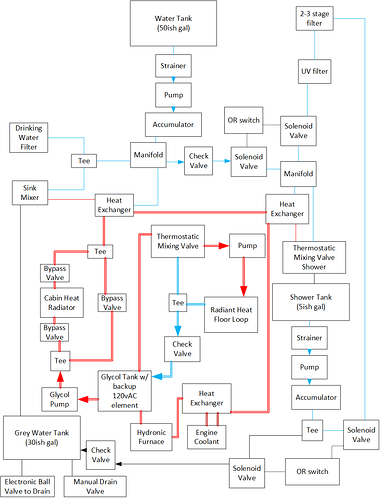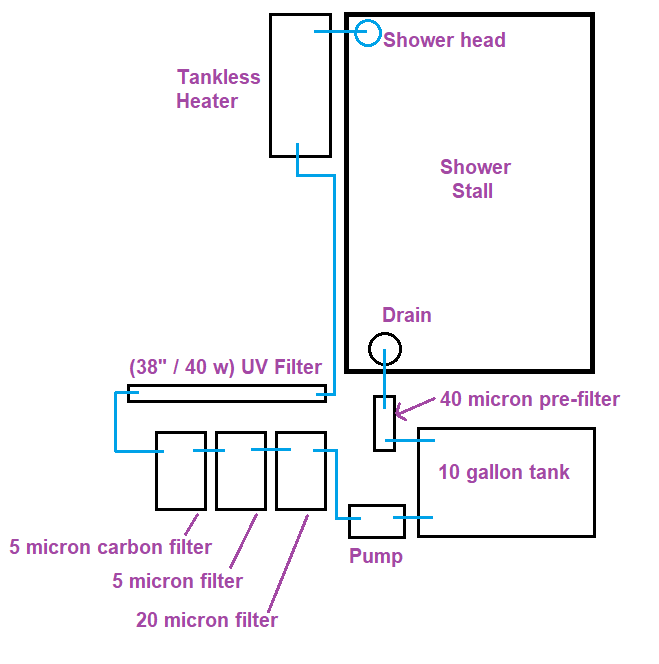Hey-o!
So I’ve got two responses here…
First Response
Cool idea! My electrician buddy that is going to be helping me with my Shuttle Bus was actually telling me about something he designed that is very similar. He was doing a “for fun” build schematic with his Engineer Father, so they really went all out like you’re thinking here, really putting the latest tech and what not into full use.
If it’s something you’re really passionate about, don’t mind spending the money, and really want to just see if you can make it work… Then go all for it man!
As for the design itself…
If you have a Grey Water Tank, then how is it recirculating? Because using a primary and secondary tank on a recirculating system just means needing an extra pump when you could just drain to the original reservoir then push through the filtration system before reusing the water. So I’m not sure I understand that fully here in your design.
Also, your “UV filter / 3 Stage Filter”, if you are draining/pulling from the same shower tank (your 5-gallon tank), then those filters would have to be moved inline after the drain but before recirculation. Shower, Filter, Recirculate, Heat, Shower, Filter, Recirculate, Heat…
As a Certified Backflow Inspector, I’m going to tell you right now, I would never connect a shower line to a drinking line. Not in a recirculating system, because Youtube and all that crap never tell the truth about recirculating systems because it’s gross, but I’m gonna call you out on it right now. When you get your stank ass in that shower and scrub your butt, you are going to be putting SOME level of fecal matter into that line. I don’t care how clean you think you are, you are going to be getting something into that line. Keeping dirt and whatnot out of the line could be achieved by regular filtration, the UV is meant to be a barrier to bacteria that manages to make it beyond that base filtration.
So the role of all the extreme filtration is literally to minimize that hazard as much as possible. The first line of defense is to remove as many particulates as possible, the second is to neutralize any contaminants through UV filtration that will hopefully destroy the bacteria to make it inert. In truth it’s actually still there, the UV light just makes it so that it is no longer functioning by destroying the DNA strands.
So actually that’s another thing, you are going to want to move the UV filter after the staged filters. The fewer particles/objects moving through that filter the better chance of it catching any and all bacteria to nullify it.
Now, just to be 100% clear, these are just my opinions based on my own experiences. Hopefully though, something I’ve suggested helps you better visualize your own goal and desire.
Second Response
You aren’t going to need that. A Buddy Heater and accepting the fact that your floors are going to be cold some days are more realistic choices, and cheaper!
So unless you really just want it, I wouldn’t even bother. I actually have the pieces and components for a similar design but with a different goal in mind. I just wanted to be able to take showers that lasted as long as I wanted and to be able to take maybe 5-10 in a week off the same 15-gallon tank.
This is my design,
It’s significantly less complex than yours, but still, even my design is a solid “95% over-engineered”. Honestly, if I hadn’t already purchased the pieces (7 months ago) I wouldn’t even bother with all this crap.
Now, it’s not just “being cheap” or sticking to “KISS” (although sticking to KISS is really always a great idea), I actually have a very practical reason for saying you probably won’t need all that.
If you were in the city, you’d have ready access to water, so wouldn’t need to “make the most” out of what you are carrying.
If you are planning on Boondocking, well unfortunately the rules and availability of that is changing drastically due to COVID. Apparently, a HUGE influx of people have been hitting the National Parks / Forests / BLM Land / Etc due to being out of work or just taking time off due to COVID. Which is great, that land is literally there for us to take advantage of.
But, apparently, these assholes are “literally” “taking advantage”. They are destroying the land, the landmarks, as well as leaving incredibly large piles of garbage. Every day I’ve seen at least one article about a park/forest/etc closing or changing their rules due to people being dirtbags. The number one rule change has been that you can only stay for up to a week now, whereas before the standard was largely 2 weeks with exceptions.
So if you are only able to boondock for a week before needing to move, there just isn’t any need to conserve as much as a recirculating system would potentially provide.
Again, just my opinion, but just want to give you an honest one. 


